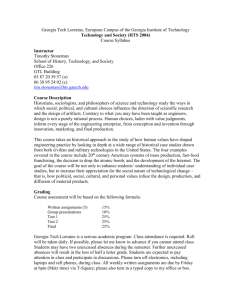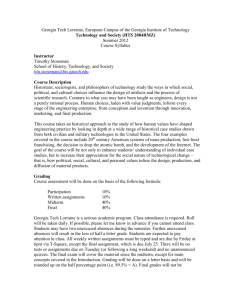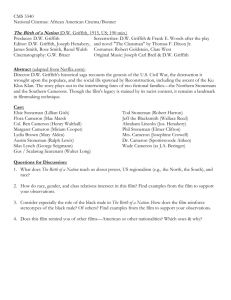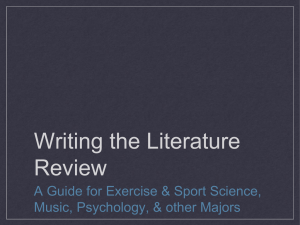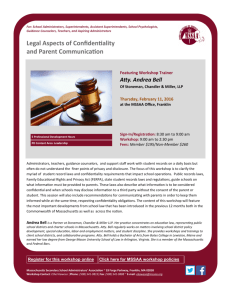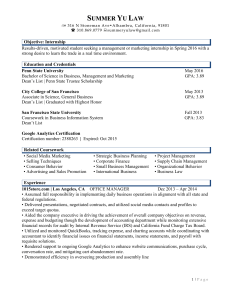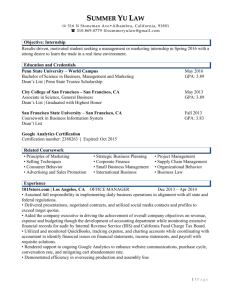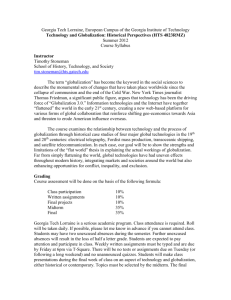Senior Research Symposium Department of Biology Spring 2005
advertisement
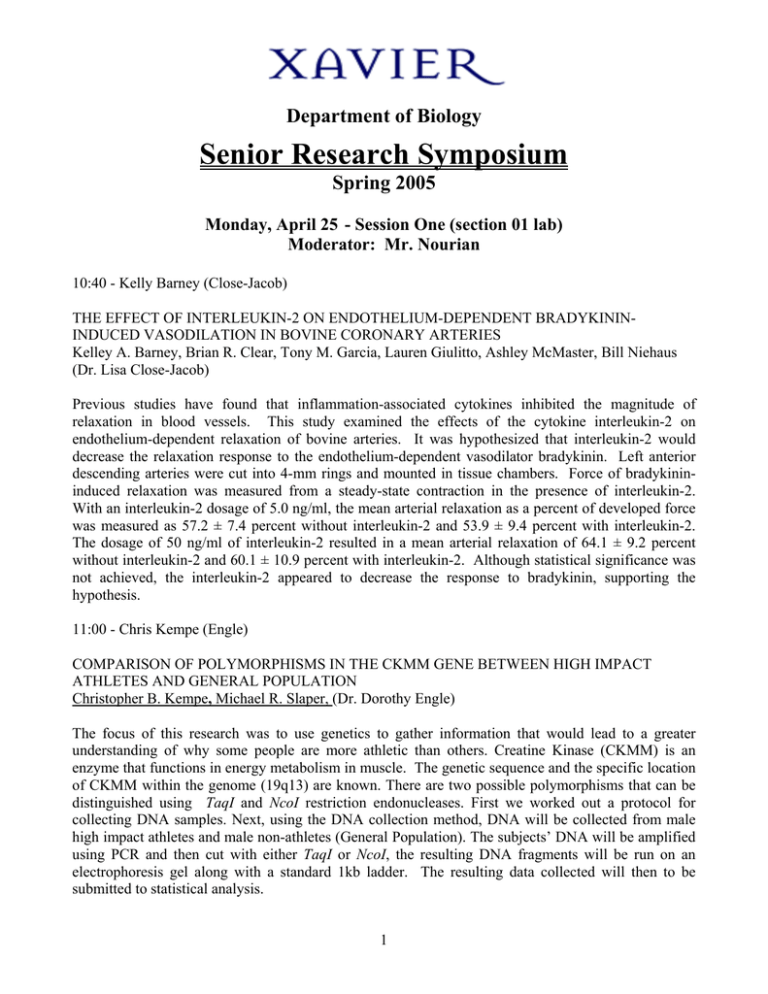
Department of Biology Senior Research Symposium Spring 2005 Monday, April 25 - Session One (section 01 lab) Moderator: Mr. Nourian 10:40 - Kelly Barney (Close-Jacob) THE EFFECT OF INTERLEUKIN-2 ON ENDOTHELIUM-DEPENDENT BRADYKINININDUCED VASODILATION IN BOVINE CORONARY ARTERIES Kelley A. Barney, Brian R. Clear, Tony M. Garcia, Lauren Giulitto, Ashley McMaster, Bill Niehaus (Dr. Lisa Close-Jacob) Previous studies have found that inflammation-associated cytokines inhibited the magnitude of relaxation in blood vessels. This study examined the effects of the cytokine interleukin-2 on endothelium-dependent relaxation of bovine arteries. It was hypothesized that interleukin-2 would decrease the relaxation response to the endothelium-dependent vasodilator bradykinin. Left anterior descending arteries were cut into 4-mm rings and mounted in tissue chambers. Force of bradykinininduced relaxation was measured from a steady-state contraction in the presence of interleukin-2. With an interleukin-2 dosage of 5.0 ng/ml, the mean arterial relaxation as a percent of developed force was measured as 57.2 ± 7.4 percent without interleukin-2 and 53.9 ± 9.4 percent with interleukin-2. The dosage of 50 ng/ml of interleukin-2 resulted in a mean arterial relaxation of 64.1 ± 9.2 percent without interleukin-2 and 60.1 ± 10.9 percent with interleukin-2. Although statistical significance was not achieved, the interleukin-2 appeared to decrease the response to bradykinin, supporting the hypothesis. 11:00 - Chris Kempe (Engle) COMPARISON OF POLYMORPHISMS IN THE CKMM GENE BETWEEN HIGH IMPACT ATHLETES AND GENERAL POPULATION Christopher B. Kempe, Michael R. Slaper, (Dr. Dorothy Engle) The focus of this research was to use genetics to gather information that would lead to a greater understanding of why some people are more athletic than others. Creatine Kinase (CKMM) is an enzyme that functions in energy metabolism in muscle. The genetic sequence and the specific location of CKMM within the genome (19q13) are known. There are two possible polymorphisms that can be distinguished using TaqI and NcoI restriction endonucleases. First we worked out a protocol for collecting DNA samples. Next, using the DNA collection method, DNA will be collected from male high impact athletes and male non-athletes (General Population). The subjects’ DNA will be amplified using PCR and then cut with either TaqI or NcoI, the resulting DNA fragments will be run on an electrophoresis gel along with a standard 1kb ladder. The resulting data collected will then to be submitted to statistical analysis. 1 PRESENTATIONS OF SENIOR RESEARCH ABSTRACTS Monday, April 25 - Session One (section 01 lab) Moderator: Mr. Nourian 11:20 - Kristen Konieczny (Grossman) MANATEE DIRECTIONAL RESPONSE TO SOUND. BEHAVIORAL PATTERNS ELICITED TO AUDIBLE SOUND FREQUENCIES MAYBE RELATED TO THE INTERACTIONS TAKING PLACE BETWEEN DIFFERENT MANATEE PAIRS Kristen Konieczny, Michelle Broest, Mary Beth Bender, Maggie Dietsch, Diva Johatan, Michelle Latham, Brad Schroeder, Kelly Smith, Sarah Whalin (Dr. Charles J. Grossman) (Faculty Advisor and Principal Investigator: C. Grossman, Other Faculty & Staff: S. Herbert, J. Johnson, D. Bellman, L Hughes, J. Vogel; Department of Biology. Xavier University, 3200 Victory Parkway, Cincinnati OH, 45207; Departments of Physics, Audiovisual and WVXU Radio. Xavier University, Cincinnati OH; Manatee Springs, Cincinnati Zoo, Cincinnati, OH. Our group has been studying acoustical responses and associated behaviors in captive manatees to learn why they are killed in boat collisions in Florida. For 3 years we studied different pairs of male manatees housed at the Cincinnati Zoo. One member of the pair was always Stoneman but 4 other males (Douglas, then Dundee, then Hurricane and finally Rodeo) were all paired for different lengths of time with Stoneman. Our observations suggested that Stoneman’s behavior changed as a result of different manatee pair interactions. Earlier we reported that when Stoneman was paired with Douglas he demonstrated significantly greater general motility (5.4 quadrants traversed or QT) vs Douglas (3.5 QT) (p =0.0000005, n=238). Now we report that from the Stoneman/Dundee pairing Stoneman’s QT was 3.69 vs Dundee’s QT of 2.54, n=61; from the Stoneman/Hurricane pairing Stoneman’s QT was 4.97 vs Hurricane’s QT of 6.62, n=143; and from the Stoneman/Rodeo pairing Stoneman’s QT was 3.08 vs Rodeo’s QT of 4.84, n=46. We hypothesize that the dominant animal in the pairing demonstrates reduced QT when compared with the submissive animal. This trend holds for Stoneman/Douglas, Stoneman/Dundee and Stoneman/Rodeo. It does not hold for Stoneman/Hurricane because Hurricane was ill and highly agitated. 11:40 - Anu Mital (Off-Campus) THE EFFECTS OF EARLY PERCUTANEOUS CORONARY INTERVENTION AND EVIDENCEBASED MEDICAL THERAPY ON LEFT VENTRICULAR FUNCTION FOLLOWING MYOCARDIAL INFARCTION. Anu Mital (Dr. Carolyn Chambers) This study investigated the effects of percutaneous coronary intervention (PCI) and medicinal therapy prescribed upon discharge on acute myocardial infarction (MI) patients’ left ventricular function. Records of 74 MI patients, with left ventricular ejection fraction (LVEF) ≤ 30%, were analyzed for the use of medicinal therapy and PCI in rehabilitating LVEF after an acute MI. The average LVEF of the patients upon discharge was 25.66±5.87%. One to three months after discharge, the average LVEF of the patients was 36.63±11.82%. At 6 months, or later, the average LVEF of the patients was 37.57±9.31%. This study shows that early restoration of perfusion following a MI, coupled with strict adherence to medical therapy, results in substantial improvement in left ventricular function at 1-3 month follow-up that is maintained to 6 months. Large-scale randomized clinical trials are needed to further substantiate these findings in this population. 2 PRESENTATIONS OF SENIOR RESEARCH ABSTRACTS Monday, April 25 - Session Two (section 02 lab) Moderator: Ms. Lewis 2:40 - Antonio Garcia (Close-Jacob) EFFECT OF INTERLEUKIN-2 ON BRADYKININ INDUCED VASODILATION OF BOVINE CORONARY ARTERIES Antonio M. Garcia, Kelley A. Barney, Brian R. Clear, Lauren M. Giulitto, Ashley M. McMaster, William N. Niehaus (Dr. Lisa Close-Jacob) Interleukin-2 is released during inflammation at the site of tissue damage. Elevated levels of circulating interleukin-2 have been measured in patients diagnosed with heart failure. The goal of this experiment was to examine the relationship between interleukin-2 and bradykinin-induced endothelium-dependent relaxation of bovine coronary arteries. Left anterior descending coronary arteries were cut into 4 mm cross sections and suspended in tissue chambers with oxygenated Krebs solution. A steady state contraction was established, and bradykinin-induced relaxation was measured in the presence of interleukin-2 and serum albumin vehicle. We hypothesized that interleukin-2 would have an inhibitory effect on the relaxation response to bradykinin. Arteries treated with interleukin-2 at different concentrations showed a reduced response to bradykinin-induced dilation compared to treatment with vehicle. Percent relaxation with interleukin-2 and vehicle: 53.9±9.4 and 57.2±7.4 (5.0 ng/ml), 60.1±10.9 and 64.1±9.2 (50.0 ng/ml). Sample size was insufficient to determine statistical significance, however, the trends observed support our hypothesis. 3:00 - Brandon Cheppa (Hedeen) THE EFFECT OF ENVIRONMENTAL FACTORS ON MACROINVERTEBRATES IN THE MILL CREEK WATERSHED Brandon Cheppa, Beth Chmelik, Kathryn Fulks, Christopher Goodman, Kelly Long, Thomas Mathews, Zachary Reid, Mark Simcoe (Dr. Stanley Hedeen) In order to examine the environmental factors that contribute to a change in a stream’s diversity a qualitative analysis of species in the Mill Creek Watershed was performed. Seven locations were used and macroinvertebrates were collected and examined at each location. Our study showed that as an area becomes more urban and the amount of channelization increases, the amount of species diversity decreases. The effect of pollution did not play a role in species diversity in the Mill Creek because pollution-sensitive organisms were obtained at each site. 3 PRESENTATIONS OF SENIOR RESEARCH ABSTRACTS Monday, April 25 - Session Two (section 02 lab) Moderator: Ms. Lewis 3:20 - Jennifer Burke (Finke) SCREENING FOR PLASMIDS FROM NITROGEN-FIXING PHOTOTROPHS FROM NATURAL SOURCES Jennifer L. Burke, Andrea L. Loeser, Ian C. Wenker (Dr. Finke) Nitrogen fixation is the process of converting atmospheric nitrogen to a reduced form of nitrogen that can be used by other organisms. Nitrogen-fixing bacteria perform this valuable process, and genes for nitrogen fixation are found in plasmids in some species. A variety of phototrophic bacteria fix nitrogen, among them the widely distributed species Rhodopseudomonas palustris. We isolated pure cultures of this organism from three different sources in the greater Cincinnati area. Pure cultures were isolated by usual microbiological techniques using nitrogen fixation as the selection dynamic. Each species was screened for nitrogen fixation using the acetylene reduction technique. Plasmid DNA was then isolated from those three nitrogen fixing cultures, using an alkaline lysis procedure. DNA samples were run on an agarose gel with E. coli as the control and stained with EtBr to visualize plasmids. Plasmids were found in two of the three isolates, those from soil and worm casting samples. 3:40 - Matthew Rowe (Paulding) EVALUATING THE RELATIONSHIP BETWEEN H2O2-ASSOCIATED OXIDATIVE STRESS AND VON HIPPEL LINDAU (VHL) PROTEIN Matt Rowe, Audrey Wysocki (Dr. Waltke Paulding) Many environmental factors, including hypoxia, can induce oxidative stress. Cells that are subjected to oxidative stress often generate reactive oxygen species (ROS), which include hydrogen peroxide (H2O2). Familial von Hippel-Lindau (VHL) disease develops in individuals that are born heterotrophic for the wild-type (wt)VHL gene, and who subsequently lose the remaining wt-VHL allele due to mutation. Excessive, unregulated quantities of ROS are known to damage cellular macromolecules, including proteins lipids and nucleic acids. We are currently examining the oxidative status of cells that express (wt-VHL) or lack (mut-VHL) the VHL protein, as a decrease in a cell’s ability to maintain “oxidative homeostasis” may be related to DNA damage, and expression of VHL pathology. Results from experiments in which H2O2 production was measured in VHL(+) or VHL(-) cell lines, under either normoxic (21% O2) or hypoxic (1% O2) conditions, revealed higher, basal amounts of H2O2 in VHL(-) cells in normoxic conditions, as contrasted to VHL(+) cells. Hypoxia reduced production of H2O2 in both VHL(+) and VHL(-) cell lines. Evaluation of expression levels of superoxide dismutase (SOD) and catalase, the 2 main enzymes involved in regulating H2O2 levels in the oxidative stress pathway, continue. 4 PRESENTATIONS OF SENIOR RESEARCH ABSTRACTS Monday, April 25 - Session Three (section 03 lab) Moderator: Dr. Farnworth 4:40 - Chris Goodman (Hedeen) UTILIZATION OF MACROINVERTEBRATES TO ASSESS EFFECTS AND STATES OF POLLUTION AND CHANNELIZATION OF THE MILL CREEK IN CINCINNATI, OH Christopher B. Goodman, Brandon Cheppa, Beth Chmelik, Kathryn Fulks, Kelly Long, Thomas Mathews, Zachary Reid, Mark Simcoe (Dr. Stanley Hedeen) The goal of this study was to assess the effects of pollution and channelizaition on the Mill Creek, and two of its tributaries: West Fork and West Fork Mill Creek in Cincinnati Ohio. This experiment was carried out by sampling various macroinvertebrate species of distinct pollution tolerances at seven locations on the Mill Creek and its tributaries. Pollution tolerant macroinvertebrate species were found at all the sampling locations, but the number of species and overall number of organisms decreased at the less natural channelized sections. This decrease in number of species and overall number of organisms in the channelized sections, while pollution tolerant species were present at all sites leads to the conclusion that channelization is the leading cause of species disappearance in the channelized parts of the studied areas. 5:00 - Michelle Broestl (Grossman) MANATEE DIRECTIONAL RESPONSE TO SOUND. BEHAVIORAL PATTERNS ELICITED TO AUDIBLE SOUND FREQUENCIES MAYBE RELATED TO THE INTERACTIONS TAKING PLACE BETWEEN DIFFERENT MANATEE PAIRS. Michelle Broestl1, Marybeth Bender1, Maggie Dietsch1, Diva Johatan1, Kristin Konieczny1, Michelle Latham1, Brad Schroeder1, Kelly Smith1, Sara Whalin1 (Dr. Charles J. Grossman) (Faculty Advisor and Principal Investigator: C. Grossman1, Other Faculty & Staff: S. Herbert2, J. Johnson2, D. Bellman2, L Hughes3, J. Vogel3; 1Department of Biology. Xavier University, 3200 Victory Parkway, Cincinnati OH, 45207; 2 Departments of Physics, Audiovisual and WVXU Radio. Xavier University, Cincinnati OH; 3Manatee Springs, Cincinnati Zoo, Cincinnati OH.) Our group has been studying acoustical responses and associated behaviors in captive manatees to learn why they are killed in boat collisions in Florida. For 3 years we studied different pairs of male manatees housed at the Cincinnati Zoo. One member of the pair was always Stoneman but 4 other males (Douglas, then Dundee, then Hurricane and finally Rodeo) were all paired for different lengths of time with Stoneman. Our observations suggested that Stoneman’s behavior changed as a result of different manatee pair interactions. Earlier we reported that when Stoneman was paired with Douglas he demonstrated significantly greater general motility (5.4 quadrants traversed or QT) vs. Douglas (3.5 QT) (p =0.0000005, n=238). Now we report that from the Stoneman/Dundee pairing Stoneman’s QT was 3.69 vs. Dundee’s QT of 2.54, n=61; from the Stoneman/Hurricane pairing Stoneman’s QT was 4.97 vs. Hurricane’s QT of 6.62, n=143; and from the Stoneman/Rodeo pairing Stoneman’s QT was 3.08 vs. Rodeo’s QT of 4.84, n=46. We hypothesize that the dominant animal in the pairing demonstrates reduced QT when compared with the submissive animal. This trend holds for Stoneman/Douglas, Stoneman/Dundee and Stoneman/Rodeo. It does not hold for Stoneman/Hurricane because Hurricane was ill and highly agitated. 5 PRESENTATIONS OF SENIOR RESEARCH ABSTRACTS Monday, April 25 - Session Three (section 03 lab) Moderator: Dr. Farnworth 5:20 - Jill Swetel (Anyonge) DIFFERENTIATION IN SKULL MORPHOLOGY AMONG WOLF-LIKE CANIDS Jill M. Swetel (Dr. William Anyonge) Within the mammalian order Carnivora, the family Canidae includes wolf-like canids that exhibit cranial and dental morphological specializations for predation. Current phylogenetic data indicates that the gray wolf is most closely related to the domestic dog, followed by the coyote and the wild dog, whereas the jackals and bush dog are more distantly related to the other wolf-like canids. This study examined the skull morphology of these species to ascertain whether there was congruence between morphology and phylogeny. Sixteen indices that were chosen to reflect skull shape and other metric properties of the skull were measured and compared among eight species of wolf-like canids. Results revealed a strong convergence among many aspects of the skull within the larger wolf-like canids (wild dog, dhole, gray wolf and bush dog) that indicate adaptations to an enhanced predatory lifestyle compared to the smaller canids with a more varied diet (coyote and jackals). 5:40 - Shawn Lewis (Off-Campus) THE EFFECTS OF A COX-2 INHIBITOR ON INTERLEUKIN-1 BETA EXPRESSION AT VARIOUS TIME POINTS FOLLOWING TRAUMATIC BRAIN INJURY IN A RAT Shawn A. Lewis (Dr. Kenneth Strauss) Brain injury is comprised of the primary insult as well as secondary injuries that occur after the insult has taken place. One type of a secondary injury, neuroinflammation, is characterized by the release of various cytokines. Interleukin-1 beta, a cytokine and an important marker for brain injury, regulates cyclooxygenase-2 (COX-2) expression. A COX-2 inhibitor has also shown to decrease IL-1 beta expression in the rat brain. This study investigated IL-1beta expression in the rat brain at various time points after brain injury in Sham, Injured, and COX-2 inhibitor treated groups. IL-1 beta expression was expected to be higher in injured groups than the least in COX-2 inhibitor treated group. Results are pending. 6 PRESENTATIONS OF SENIOR RESEARCH ABSTRACTS Tuesday, April 26 - Session Four (section 04 lab) Moderator: Mr. Nourian 8:10 - Brian Clear (Close-Jacob) EFFECTS OF INTERLEUKIN-2 ON BRADYKININ-INDUCED DILATION IN THE BOVINE LEFT ANTERIOR DESCENDING CORONARY ARTERY Brian R. Clear , Kelley A. Barney,Tony M. Garcia, Lauren Guilitto, Ashley McMaster, Bill Niehaus (Dr. Lisa Close-Jacob) Cytokines are found in elevated concentrations in heart disease and heart failure patients. It has been shown that some cytokines cause vasoconstriction or inhibit bradykinin-induced vasodilation. Either of these effects may aggravate heart attacks by restricting blood supply to cardiac tissue. In this study, the effects of IL-2 on bradykinin-induced vasodilation were measured as a percentage of a previouslyinduced, irreversible contraction in cross-sections of bovine coronary artery. The presence of IL-2 was expected to inhibit dilation, and increased IL-2 concentration was expected to increase the inhibitory effect. Tissue exposed to 5.0ng/ml IL-2 relaxed by 53.9 ± 9.4 percent. Corresponding control tissue relaxed by 57.2±7.4 percent. Tissue exposed to 50ng/ml IL-2 relaxed by 60.1±10.9 percent. Control tissue relaxed by 64.1±9.1 percent. Data indicate that IL-2 does seem to inhibit the effect of bradykinin, but results did not reach statistical significance. The effects of IL-2 do not increase significantly at the higher concentration. 8:30 - Mark Simcoe (Hedeen) MACRROINVERTEBRATE SURVEY OF THE MILL CREEK AND ITS TRIBUTARIES Mark Simcoe, Beth Chmelik, Brandon Cheppa, Katie Fulks, Christopher Goodman, Kelly Long, Thomas Mathews, Zach Reid (Dr. Stanley Hedeen) The Mill Creek is one of many urban waterways that have been plagued with pollution from innumerable sources. Physical channelization of the waterway and its tributaries has also occurred to render it more tolerable to the urban environment. One of the ways to gauge water and habitat quality is to study the types of organisms that are capable of living in the ecosystem which it provides. Various sites of collection along the Mill Creek and two of its tributaries have shown that the water is capable of producing habitat for pollution sensitive, as well as pollution tolerant and pollution intermediate, organisms. This indicates that the quality of the water with regards to chemical pollution may be improving. The quality of the physical habitat is still suspect, however, as biological diversity does seem to decrease in more urban and channelized locations. 7 PRESENTATIONS OF SENIOR RESEARCH ABSTRACTS Tuesday, April 26 - Session Four (section 04 lab) Moderator: Mr. Nourian 8:50 - Ian Wenker (Finke) SCREENING FOR PLASMIDS FROM NITROGEN-FIXING PHOTOTROPHS FROM NATURAL SOURCES Ian C. Wenker, Jennifer L. Burke, Andrea L. Loeser (Dr. Finke) Nitrogen fixation is the process of converting atmospheric nitrogen to a reduced form of nitrogen that can be used by other organisms. Nitrogen-fixing bacteria perform this valuable process, and genes for nitrogen fixation are found in plasmids in some species. A variety of phototrophic bacteria fix nitrogen, among them the widely distributed species Rhodopseudomonas palustris. We isolated pure cultures of this organism from three different sources in the greater Cincinnati area. Pure cultures were isolated by usual microbiological techniques using nitrogen fixation as the selection dynamic. Each species was screened for nitrogen fixation using the acetylene reduction technique. Plasmid DNA was then isolated from those three nitrogen fixing cultures, using an alkaline lysis procedure. DNA samples were run on an agarose gel with E. coli as the control and stained with EtBr to visualize plasmids. Plasmids were found in two of the three isolates, those from soil and worm casting samples. 9:10 - Jennifer Groszek (Anyonge) THE EVOLUTION OF SKULL SHAPE IN CANIS FAMILIARIS Jennifer L. Groszek (Dr. William Anyonge) The mammalian genus Canis is comprised of eight species of coyotes, dogs, jackals, and wolves. All of the species have been known to hybridize, making it possible for any to be the ancestor of the domestic dog (Canis familiaris). Genetic and morphological studies suggest that the closest relative to the domestic dog is the grey wolf (Canis lupus). In this study, fourteen cranial measurements were taken of the skulls of eight domestic dog breeds and the grey wolf to determine the degree of similarity of the skull proportions of the two species. It was hypothesized that there would be significant similarity in the skull proportions of the domestic dog and the grey wolf. The findings of this study show that there are no significant differences in any of the cranial proportions of the domesticated dog and the grey wolf. These results are consistent with the hypothesis that during the evolution of Canis familiaris, the skull proportions have not significantly diverged from those of Canis lupus. 8 PRESENTATIONS OF SENIOR RESEARCH ABSTRACTS Tuesday, April 26 - Session Five (section 05 lab) Moderator: Mr. Nourian 10:20 - Danielle Erney (Off-Campus) P21-ACTIVATED KINASE 1 PROTEIN EXPRESSION LEVELS IN HYPERPLASTIC AND MALIGNANT BREAST TISSUE CELL LINES Danielle M. Erney (Dr. Julia Carter, Dr. Bonnie Richmond, Dr. Carolyn Chambers) The purpose of this study was to examine expression levels of the p21-activated kinase 1 (Pak1) protein in hyperplastic and breast cancer cell lines. Pak1 protein is involved in cellular functions such as cytoskeletal reorganization and intracellular signaling. From previously performed immunohistochemistry (IHC) studies, we anticipated increased Pak1 expression with progression of the disease. Six established breast cell lines were utilized in the study. One of the cell lines was hyperplastic, defined as genetically altered cells resulting in an abnormal increase in cell growth. The remaining five cell lines were malignant, ranging from non-metastatic to highly aggressive and metastatic tumor cells. Western blotting and protein determination procedures were used to compare these cell lines, and results will be presented when assays are complete and the data has been analyzed. 10:40 - Colin Lane (Engle) CONSTRUCTION OF A PLASMID CONTAINING A DISRUPTED HYPOTHETICAL INTERMEDIATE FILAMENT GENE FROM ASPERGILLUS NIDULANS Colin K. Lane (Dr. Dorothy Engle) This experiment was undertaken to construct a new plasmid which would contain a hypothetical intermediate filament gene from Aspergillus nidulans, which would be interrupted by a selectable marker, the pyr4 gene from Neurospora crassa. First, the hypothetical gene was removed from the Aspergillus nidulans genome and ligated into pGEM-3Zf+ plasmid. After removing the selectable marker from a separate plasmid it was inserted into the hypothetical gene through blunt end ligation. It was found that the fragment containing the hypothetical gene was approximately 6kb long. The pyr4 gene was approximately 3.1kb long. After the insertion of the pyr4 gene, colony clots indicated that they hypothetical gene was interrupted. But when it was digested with several enzymes, unexpected fragments appeared. This could be caused by multiple insertions of extraneous DNA fragments into the hypothetical gene. More experiments need to be performed to confirm that this construct is the plasmid wanted. 9 PRESENTATIONS OF SENIOR RESEARCH ABSTRACTS Tuesday, April 26 - Session Five (section 05 lab) Moderator: Mr. Nourian 11:00 - Zach Reid (Hedeen) A QUALITATIVE STUDY OF BENTHIC MACROINVERTEBRATE DIVERSITY IN THE MILL CREEK AND ITS BRANCHES Zachary T. Reid, Brandon Cheppa, Beth Chmelik, Kathryn Fulks, Christopher Goodman, Kelly Long, Thomas Mathews, Mark Simcoe (Dr. Stanley Hedeen) This study on the health of the aquatic ecosystem in the Mill Creek and two of its tributaries was undertaken by collecting benthic macroinvertebrates from seven selected sites along the streams and comparing them to one another. We hypothesized that as we moved downstream towards the city total species numbers and pollution-sensitive species numbers would decline. After collecting and analyzing our data we found that in two out of three of the streams there was a decline in total species but there was no decline in pollution-sensitive species. Channelization and not pollution was the main problem since pollution-sensitive organisms were found at every. 11:20 - Kelly Smith (Grossman) MANATEE DIRECTIONAL RESPONSE TO SOUND. BEHAVIORAL PATTERNS ELICITED TO AUDIBLE SOUND FREQUENCIES MAYBE RELATED TO THE INTERACTIONS TAKING PLACE BETWEEN DIFFERENT MANATEE PAIRS. Kelly Smith1, Michelle Broestl1, Mary Beth Bender1, Maggie Dietsch1, Diva Jonatan1, Kristen Konieczny1, Michelle Latham1, Brad Schroeder1, Sara Whalin1 (Dr. Charles J. Grossman) (Faculty Advisor and Principal Investigator: C. Grossman1, Other Faculty & Staff: S. Herbert2, J. Johnson2, D. Bellman2, L Hughes3, J. Vogel3; 1Department of Biology. Xavier University, 3200 Victory Parkway, Cincinnati OH, 45207; 2Departments of Physics, Audiovisual and WVXU Radio. Xavier University, Cincinnati OH; 3Manatee Springs, Cincinnati Zoo, Cincinnati OH.) Our group has been studying acoustical responses and associated behaviors in captive manatees to learn why they are killed in boat collisions in Florida. For 3 years we studied different pairs of male manatees housed at the Cincinnati Zoo. One member of the pair was always Stoneman but 4 other males (Douglas, then Dundee, then Hurricane and finally Rodeo) were all paired for different lengths of time with Stoneman. Our observations suggested that Stoneman’s behavior changed as a result of different manatee pair interactions. Earlier we reported that when Stoneman was paired with Douglas he demonstrated significantly greater general motility (5.4 quadrants traversed or QT) vs Douglas (3.5 QT) (p =0.0000005, n=238). Now we report that from the Stoneman/Dundee pairing Stoneman’s QT was 3.69 vs Dundee’s QT of 2.54, n=61; from the Stoneman/Hurricane pairing Stoneman’s QT was 4.97 vs Hurricane’s QT of 6.62, n=143; and from the Stoneman/Rodeo pairing Stoneman’s QT was 3.08 vs Rodeo’s QT of 4.84, n=46. We hypothesize that the dominant animal in the pairing demonstrates reduced QT when compared with the submissive animal. This trend hold for Stoneman/Douglas, Stoneman/Dundee and Stoneman/Rodeo. It does not hold for Stoneman/Hurricane because Hurricane was ill and highly agitated. 10 PRESENTATIONS OF SENIOR RESEARCH ABSTRACTS Tuesday, April 26 - Session Six (section 06 lab) Moderator: Mr. Nourian 2:40 - Andrea Loeser (Finke) SCREENING FOR PLASMIDS FROM NITROGEN-FIXING PHOTOTROPHS FROM NATURAL SOURCES Andrea L. Loeser, Jennifer L. Burke, Ian C. Wenker (Dr. Finke) Nitrogen fixation is the process of converting atmospheric nitrogen to a reduced form of nitrogen that can be used by other organisms. Nitrogen-fixing bacteria perform this valuable process, and genes for nitrogen fixation are found in plasmids in some species. A variety of phototrophic bacteria fix nitrogen, among them the widely distributed species Rhodopseudomonas palustris. We isolated pure cultures of this organism from three different sources in the greater Cincinnati area. Pure cultures were isolated by usual microbiological techniques using nitrogen fixation as the selection dynamic. Each species was screened for nitrogen fixation using the acetylene reduction technique. Plasmid DNA was then isolated from those three nitrogen fixing cultures, using an alkaline lysis procedure. DNA samples were run on an agarose gel with E. coli as the control and stained with EtBr to visualize plasmids. Plasmids were found in two of the three isolates, those from soil and worm casting samples. 3:00 - Tom Mathews (Hedeen) THE EFFECT OF SUBSTRATE SURFACES ON MACROINVERTEBRATE POPULATIONS IN CHANNELIZED AND NON-CHANNELIZED SITES OF THE MILL CREEK Thomas Mathews, Brandon Cheppa, Beth Chmelik, Kathryn Fulks, Christopher Goodman, Kelly Long, Zachary Reid, Mark Simcoe (Dr. Stanley Hedeen) Macroinvertebrate species collected in rural and urban areas decreased in quantity due to habitat change, not water pollution. Channelization in urban areas has led to a loss of suitable habitat for many macroinvertebrate species. Channelized streams lack the rough and rocky substrate surface conducive for macroinvertebrate life. Seven sampling sites were used in this study: three on the main stem of the Mill Creek, two on West Fork, and two on West Fork Mill Creek. Macroinvertebrate species were collected from each site and identified as pollution sensitive, pollution intermediate, or pollution tolerant. The sites all contained at least one pollution sensitive species, ruling out the possibility of pollution as a factor in the decrease in species number. Channelization’s purpose is to move water quickly. Rapidly moving water over a bare substrate offers limited habitats for benthic macroinvertebrates to live. 11 PRESENTATIONS OF SENIOR RESEARCH ABSTRACTS Tuesday, April 26 - Session Six (section 06 lab) Moderator: Mr. Nourian 3:20 - Brad Schroeder (Grossman) IS THE DURATION OF MANATEE PAIR VOCALIZATIONS A POSSIBLE FORM OF INTERMANATEE COMMUNICATIONS? Brad Schroeder (Dr. Charles J. Grossman) (Faculty Advisor and Principal Investigator: C. Grossman1, Other Faculty & Staff: S. Herbert2, J. Johnson2, L Hughes3, J. Vogel3; 1Department of Biology. Xavier University, 3200 Victory Parkway, Cincinnati OH, 45207; 2Departments of Physics, and WVXU Radio. Xavier University, Cincinnati OH; 3Manatee Springs, Cincinnati Zoo, Cincinnati OH.) Our group has been studying acoustical responses and associated behaviors in captive manatees to learn why they are killed in boat collisions in Florida. Over a 3 year period we recorded manatee vocalizations produced between different pairs of male manatees. One member of the pair was always Stoneman but under the direction of the US Fish and Wildlife Service four other males (Douglas, then Dundee, then Hurricane and finally Rodeo) were paired with Stoneman. During our studies we digitally recorded over 1800 manatee vocalizations produced by these four manatee pairs. These recorded vocalizations were then analyzed based on the duration (in seconds) vs the frequency of occurrence (number of durations counted). Our preliminary findings suggest that the duration of the pair vocalizations of Douglas/Stoneman (X=0.236; SD =0.054; n=1358) appear similar to those of Hurricane/Stoneman (X=0.235, SD=0.059; (n=293). However, the pair vocalizations generated from Dundee/Stoneman appear to be shorter in duration (X=0.227; SD=0.046; n=118). Data from Rodeo/Stoneman is still being collected and statistical calculations on the results will be run upon completion. We hypothesize that differences in vocalization patterns resulted from the aggressive behavior of Dundee towards Stoneman. Our observations suggested that the vocalization patterns changed during the different pair interactions. 3:40 - Jennifer Smolinski (Farnsworth) NUMERICAL COMPETENCE IN WILD NORTHERN MOCKINGBIRDS (Mimus polyglottos) Jennifer L. Smolinski (Dr. George Farnsworth) This study attempted to determine the numerical competence of wild Northern mockingbirds (Mimus polyglottos). Five individually color-banded mockingbirds on campus were presented with experimental feeders designed to test numerical discrimination. To obtain mealworms, a mockingbird needed to remove all sticks from one side of the apparatus. We hypothesized that subjects would remove sticks from the side containing fewer sticks to obtain a food reward more quickly and easily. The birds were presented with trials involving random placement and number of sticks. Statistical analysis of the data was then carried out using one-tailed sign tests. All five mockingbirds successfully discriminated between 1 stick and 6 sticks and between 2 sticks and 5 sticks, by consistently choosing the end with fewer sticks. All five subjects failed to discriminate between 3 and 4 sticks. These results demonstrate the limited capacity of wild mockingbirds to solve optimal foraging problems on the basis of number. 12 PRESENTATIONS OF SENIOR RESEARCH ABSTRACTS Wednesday, April 27 - Session Seven (section 07 lab) Moderator: Mr. Nourian 10:30 - Katie Fulks (Hedeen) THE EFFECT OF CHANNELIZATION ON STREAM MACROINVERTEBRATE DIVERSITY Kathryn M. Fulks, Brandon Cheppa, Beth Chmelik, Christopher Goodman, Kelly Long, Thomas Mathews, Zachary Reid, Mark Simcoe (Dr. Stanley Hedeen) In this study the effects of channelization on species diversity were investigated. Macroinvertebrates were chosen for the study because they are easy to survey. To look at the effects of channelization, three independent studies from the main stem and tributaries of the Mill Creek were included. Two of the studies showed that species diversity decreased as channelization increased, while the third study was inconclusive. 10:50 - Lisa Pietropaolo (Jacob) IDENTIFICATION OF SEROTONIN RECEPTORS LOCATED ON LACTATING MOUSE MAMMARY GLAND EPITHELIUM Elisabetta Pietropaolo, Zachary Berrens, (Dr. George A. Jacob) Prolactin up-regulates the expression of tryptophan hydroxylase (TPH) in mouse mammary epithelium. TPH is the rate limiting enzyme that catalyses tryptophan to 5-Hydroxytryptamine (5-HT) or serotonin. Serotonin is an amine neurotransmitter synthesized and released in the brain. Prior studies suggest that serotonin in the mammary gland plays a role in involution after weaning. In order to completely determine the function of 5-HT in the mouse mammary gland, the serotonin receptor that is utilized must be identified. Seven distinct classes of 5-HT receptors have been discovered. Preliminary PCR analysis of extracts from mouse mammary gland epithelium indicated the presence of 5-HT2A receptor mRNA. Mouse mammary gland epithelium extracts were subjected to SDS-PAGE, and subsequently probed with antibody to detect the presence of the 5-HT2A protein. If 5-HT2A is present, Western analysis will reveal a 55 kD. protein. 13 PRESENTATIONS OF SENIOR RESEARCH ABSTRACTS Wednesday, April 27 - Session Seven (section 07 lab) Moderator: Mr. Nourian 11:10 - Ty Stratton (Off-Campus) EXAMINATION OF TRANSCYTOSIS OF HDL ACROSS THE PLACENTA AND YOLK SAC IN THE MOUSE Tyler E. Stratton (Dr. Laura Woollett) Developing fetuses require cholesterol for several aspects of development, including membrane formation and hormone synthesis. The purpose of this study was increase the understanding of the mechanisms of cholesterol transport to the fetus by examining whether or not holo-HDL particles are able to transcytose either the placenta or yolk sac to reach the fetal circulation. Female mice heterozygous for apoA-I were mated with knockout males. Plasma samples from the resulting fetal apoA-I knockout mice were examined by immunoblot analysis for the presence of apoA-I. The results revealed no banding at 28 kDa, the molecular weight of apoA-I protein. Therefore, it appears that holo-HDL particles are not capable of crossing the polar cells of either the placenta or yolk sac. 11:30 – Mary Beth Bender (Grossman) MANATEE DIRECTIONAL RESPONSE TO SOUND. BEHAVIORAL PATTERNS ELICITED TO AUDIBLE SOUND FREQUENCIES MAY BE RELATED TO THE INTERACTIONS TAKING PLACE BETWEEN DIFFERENT MANATEE PAIRS. Mary Beth Bender, Michelle Broestl, Maggie Dietsch, Diva Johatan, Kristen Konieczny, Michelle Latham, Brad Schroeder, Kelly Smith, Sara Whalin (Dr. Charles Grossman) Our group has been studying acoustical responses and associated behaviors in captive manatees to learn why they are killed in boat collisions in Florida. For three years we studied different pairs of male manatees housed at the Cincinnati Zoo. One member of the pair was always Stoneman but four other males (Douglas, Dundee, Hurricane and finally Rodeo) were all paired for different lengths of time with Stoneman. Our observations suggested that Stoneman’s behavior changed as a result of different manatee pair interactions. Earlier we reported that when Stoneman was paired with Douglas he demonstrated significantly greater general motility (5.4 quadrants traversed or QT) vs Douglas (3.5 QT) (p =0.0000005, n=238). Now we report that from the Stoneman/Dundee pairing Stoneman’s QT was 3.69 vs Dundee’s QT of 2.54, n=61; from the Stoneman/Hurricane pairing Stoneman’s QT was 4.97 vs Hurricane’s QT of 6.62, n=143; and from the Stoneman/Rodeo pairing Stoneman’s QT was 3.08 vs Rodeo’s QT of 4.84, n=46. We hypothesize that the dominant animal in the pairing demonstrates reduced QT when compared with the submissive animal. This trend held for Stoneman/Douglas, Stoneman/Dundee and Stoneman/Rodeo. It does not hold for Stoneman/Hurricane because Hurricane was ill and highly agitated. 14 PRESENTATIONS OF SENIOR RESEARCH ABSTRACTS Wednesday, April 27 - Session Eight (section 08 lab) Moderator: Ms. Lewis 2:30 - Elizabeth Bertsch (Engle) A DETERMINATION OF EFFECTIVENESS OF CELL WALL LYSING ENZYMES ON THE FORMATION OF PROTOPLASTS IN ASPERGILLUS NIDULANS Elizabeth Bertsch (Dr. Dottie Engle) The cell wall lysing enzymes, Driselase, β-D-Glucanase, T. harzianum Lysing Enzyme, and a combination of Driselase, β-D-Glucanase, and yeast lytic enzyme, were tested for effectiveness when used to lyse cell walls of Aspergillus nidulans to form protoplasts, and were chosen based on the results of previous studies. It was hypothesized T. harzianum Lysing Enzyme would be the most effective in protoplast formation. The protoplasting protocol was derived from the Aspergillus transformation procedure from James (1999). The protoplasts were checked at 1 hour, 1.5 hours, and 2 hours; and at each interval, a sample of the protoplasts in each enzyme solution was counted by use of a hemocytometer and numeration was determined per gram weight of mycelia. Based on these counts, the lysing enzyme, β-D-Glucanase, was determermined to be the most effective. However, the enzyme, Driselase, produced a similar amount of protoplasts which appeared healthier and the mycelia less aggregated. 2:50 - Kelly Long (Hedeen) THE EFFECTS OF HABITAT MODIFICATION ON MACROINVERTEBRATE SPECIES DIVERSITY IN THE MILL CREEK Kelly Long, Brandon Cheppa, Beth Chmelik, Kathryn Fulks, Christopher Goodman, Thomas Mathews, Zachary Reid, Mark Simcoe (Dr. Stanley Hedeen) This research was undertaken to study the effect of habitat modification on the benthic macroinvertebrate populations of the Mill Creek. To study the effects of habitat modification, 7 stations were established at various locations along the Mill Creek, in the fall of 2004. Eight students collected the organisms and eventually studied them in the lab, determining whether the species were pollution-sensitive, pollution-intermediate, or pollution-tolerant. More importantly, the overall abundances of the species were recorded. The study showed that as the Mill Creek became more channelized, the overall abundances of the species decreased. In addition, pollution-sensitive organisms were found at every site sampled along the Creek, and therefore, pollution was ruled out as a factor contributing to the decrease in macroinvertebrate abundance. The hypothesis was supported: channelization decreases the abundance of macroinvertebrates. 15 PRESENTATIONS OF SENIOR RESEARCH ABSTRACTS Wednesday, April 27 - Session Eight (section 08 lab) Moderator: Ms. Lewis 3:10 - Maggie Dietsch (Grossman) MANATEE DIRECTIONAL RESPONESE TO SOUND. BEHAVIORAL PATTERNS ELICITED TO AUDIBLE SOUND FREQUENCIES MAYBE RELATED TO THE INTERACTIONS TAKING PLACE BETWEEN DIFFERENT MANATEE PAIRS. M. A. Dietsch1, M. Broestl1, M. Bender1, , D. Johatan1, K. Konieczny1, M. Latham1, B. Schroeder1, K. Smith1, S. Whalin1 (Dr. Charles Grossman) Our group has been studying acoustical responses and associated behaviors in captive manatees to learn why they are killed in boat collisions in Florida. For 3 years we studied different pairs of male manatees housed at the Cincinnati Zoo. One member of the pair was always Stoneman but 4 other males (Douglas, then Dundee, then Hurricane and finally Rodeo) were all paired for different lengths of time with Stoneman. Our observations suggested that Stoneman’s behavior changed as a result of different manatee pair interactions. Earlier we reported that when Stoneman was paired with Douglas he demonstrated significantly greater general motility (5.4 quadrants traversed or QT) vs Douglas (3.5 QT) (p =0.0000005, n=238). Now we report that from the Stoneman/Dundee pairing, Stoneman’s QT was 3.69 vs Dundee’s QT of 2.54, n=61; from the Stoneman/Hurricane pairing, Stoneman’s QT was 4.97 vs Hurricane’s QT of 6.62, n=143; and from the Stoneman/Rodeo pairing, Stoneman’s QT was 3.08 vs Rodeo’s QT of 4.84, n=46. We hypothesize that the dominant animal in the pairing demonstrates reduced QT when compared with the submissive animal. This trend holds for Stoneman/Douglas, Stoneman/Dundee and Stoneman/Rodeo. It does not hold for Stoneman/Hurricane because Hurricane was ill and highly agitated. 3:30 - Holly Funk (Finke) THE EFFECT OF PERCHLORATE ON A POSSIBLE PHYTOREMEDIATING LEGUME TRIFOLIUM REPENS AND ITS NITROGEN-FIXING BACTERIAL SYMBIONT RHIZOBIUM MELILOTI Holly M. Funk (Dr. Linda Finke) The perchlorate anion (ClO4⎯), mainly used as a rocket propellant oxidizer, is a contaminant that is detected in all the U.S. Phytoremediation, using plants to extract contaminants out of soil, has been shown to successfully remove perchlorate in wetland areas. However, the most perchloratecontaminated area of the U.S. is the southwest with its arid, low-nitrogen soil condition. Leguminous plants endure these conditions due to symbiotic relationships formed with bacteria that are able to provide organic nitrogen to the plant from N2. The legume New Zealand White Clover (Trifolium repens), along with its nitrogen-fixing symbiont (Rhizobium meliloti), were grown in perchloratecontaminated, sandy soil. The plants were tested for nitrogen-fixation by an acetylene reduction assay, and the amount of perchlorate remaining in the soil was quantitated by methylene blue precipitation. Thus, the ability of the symbiosis to survive and remediate perchlorate from soil was determined. 16 PRESENTATIONS OF SENIOR RESEARCH ABSTRACTS Wednesday, April 27 - Session Nine (section 09 lab) Moderator: Dr. Farnsworth 4:30 - William Niehaus (Close-Jacob) THE EFFECT OF INTERLEUKIN-2 ON THE PERCENT RELAXATION OF BOVINE CORONARY ARTERIES EXPOSED TO BRADYKININ William N. Niehaus, Kelley A. Barney, Brian R. Clear, Anthony M. Garcia, Lauren Giulitto, and Ashley M. McMaster (Dr. Lisa Close-Jacob) This study showed bovine coronary arteries, in the presence of interleukin-2, have decreased endothelium driven dilatory responses to bradykinin similar to the effects of interleukin-6. Four millimeter artery cross-sections, obtained from fresh bovine hearts, were dissected in cold Kreb's solution and hung in glass tissue chambers that mimicked in vivo conditions. U46619 was added to induce a permanent contraction to enable a comparison of bradykinin-induced relaxations. Vehicle or IL-2 was then added at either 5.0 ng/mL or 50 ng/mL prior to adding bradykinin to induce relaxation. Although there were no statistically significant findings, the expected trend was observed. Arteries exposed to 5.0 ng/ml of IL-2 had a bradykinin-induced relaxation which was 94.2% of the mean response of arteries given vehicle only. Arteries exposed to 50 ng/ml IL-2 had a similar bradykinininduced relaxation that was 93.8% of the mean response of vehicle treated arteries. 4:50 - Kevin Bosse (Engle) IDENTIFICATION OF A NOVEL GENE IN APERGILLUS NIDULANS Kevin Bosse (Dr. Dottie Engle) With the whole genome sequencing of Aspergillus nidulans, many hypothetical genes and proteins have been identified. One such gene is locus AN6669.2, which is shown by BLAST analysis to be similar to MSTA, a member of the monosaccharide transport superfamily. MSTA proteins have been shown to be responsible for the transport of D-glucose primarily, as well D-fructose and D-mannose in species of filamentous fungi such as Aspergillus niger. I am using a new method, Double-jointed PCR, to create a knockout cassette containing a pyr4 resistance marker. Homologous double crossover will then be used to delete the gene within Aspergillus nidulans and a phenotype will be deduced. Successful recombinants will be grown on nutrient-specific mediums to help further understand the function of the gene. 17 PRESENTATIONS OF SENIOR RESEARCH ABSTRACTS Wednesday, April 27 - Session Nine (section 09 lab) Moderator: Dr. Farnsworth 5:10 - Audrey Wysocki (Paulding) EVALUATING THE RELATIONSHIP BETWEEN H2O2-ASSOCIATED OXIDATIVE STRESS AND VON HIPPEL LINDAU (VHL) PROTEIN Audrey Wysocki , Matt Rowe (Dr. Waltke Paulding) Many environmental factors, including hypoxia, can induce oxidative stress. Cells that are subjected to oxidative stress often generate reactive oxygen species (ROS), which include hydrogen peroxide (H2O2). Familial von Hippel-Lindau (VHL) disease develops in individuals that are born heterotrophic for the wild-type (wt)VHL gene, and who subsequently lose the remaining wt-VHL allele due to mutation. Excessive, unregulated quantities of ROS are known to damage cellular macromolecules, including proteins lipids and nucleic acids. We are currently examining the oxidative status of cells that express (wt-VHL) or lack (mut-VHL) the VHL protein, as a decrease in a cell’s ability to maintain “oxidative homeostasis” may be related to DNA damage, and expression of VHL pathology. Results from experiments in which H2O2 production was measured in VHL(+) or VHL(-) cell lines, under either normoxic (21% O2) or hypoxic (1% O2) conditions, revealed higher, basal amounts of H2O2 in VHL(-) cells in normoxic conditions, as contrasted to VHL(+) cells. Hypoxia reduced production of H2O2 in both VHL(+) and VHL(-) cell lines. Evaluation of expression levels of superoxide dismutase (SOD) and catalase, the 2 main enzymes involved in regulating H2O2 levels in the oxidative stress pathway, continue. 5:30 - Lawrence McCullough (Finke) NITROGENASE ACTIVITY IN WOODY TISSUE INFESTED WITH TERMITES AND NITROGENASE ACTIVITY IN TERMITES (RETICULITERMES FLAVIPES) AS RELATED TO TEMPERATURE Lawrence I. McCullough II (Dr. Linda Finke) Termites, by use of spirochetes in their intestines, perform nitrogen fixation in order to supplement their nitrogen poor diet of woody plant tissue. The goal of this project is to demonstrate nitrogen fixation in the worker termites collected from the local environment, and to assess the impact of temperature on this activity. It is predicted that termites will show higher nitrogenase activity at higher temperatures in the range of 20 to 30º Celsius. Samples of termites were collected from decomposing logs in a local woodland and tested for nitrogenase activity by use of the reduction of acetylene to ethylene. The first initial experiment with eighteen worker termites did not indicate the presence of nitrogenase but the second experiment done with fifty worker termites indicated a small amount of nitrogenase activity. In addition, a related study concerning the nitrogenase activity of microorganisms active in woody tissue was conducted with two termite-infested logs. Decomposing wood from one of the logs showed relatively high nitrogenase activity. 18 PRESENTATIONS OF SENIOR RESEARCH ABSTRACTS Thursday, April 28 - Session Ten (section 10 lab) Moderator: Mr. Nourian 8:00 - Michael Slaper (Engle) COMPARISON OF POLYMORPHISMS IN THE CKMM GENE BETWEEN HIGH IMPACT ATHLETES AND GENERAL POPULATION Michael R. Slaper, Christopher B. Kempe (Dr. Dorothy Engle) The focus of this research was to use genetics to gather information that would lead to a greater understanding of why some people are more athletic than others. Creatine Kinase (CKMM) is an enzyme that functions in energy metabolism in muscle. The genetic sequence and the specific location of CKMM within the genome (19q13) are known. There are two possible polymorphisms that can be distinguished using TaqI and NcoI restriction endonucleases. First we worked out a protocol for collecting DNA samples. Next, using the DNA collection method, DNA will be collected from male high impact athletes and male non-athletes (General Population). The subjects’ DNA will be amplified using PCR and then cut with either TaqI or NcoI, the resulting DNA fragments will be run on an electrophoresis gel along with a standard 1kb ladder. The resulting data collected will then to be submitted to statistical analysis. 8:20 - Beth Chmelik (Hedeen) THE EFFECT OF CHANNELIZATION ON MACROINVERTEBRATE DIVERSITY IN AN URBAN STREAM Beth A. Chmelik, Brandon Cheppa, Kathryn Fulks, Christopher Goodman, Kelly Long, Thomas Mathews, Zachary Reid, Mark Simcoe (Dr. Stanley Hedeen) The purpose of this study was to determine the effect of stream modification on macroinvertebrate diversity in an urban stream. It was hypothesized that stream modification causes a reduction in macroinvertebrate diversity. To test this hypothesis, several sites along Mill Creek were analyzed and the data obtained at the more natural sites were compared to the data obtained at the channelized sites. The study results show that there was less macroinvertebrate diversity in the channelized sections of the stream and more diversity in the natural sections of the stream. 19 PRESENTATIONS OF SENIOR RESEARCH ABSTRACTS Thursday, April 28 - Session Ten (section 10 lab) Moderator: Mr. Nourian 8:40 - Sara Whalin (Grossman) MANATEE DIRECTIONAL RESPONSE TO SOUND. BEHAVIORAL PATTERNS ELICITED TO AUDIBLE SOUND FREQUENCIES MAY BE RELATED TO THE INTERACTIONS TAKING PLACE BETWEEN DIFFERENT MANATEE PAIRS. S. Whalin1, M. Broestl1, M. Bender1, M. Dietsch1, D. Johatan1, K. Konieczny1, M. Latham1, B. Schroeder1, K. Smith1 (Dr. Charles J. Grossman) (Faculty Advisor and Principal Investigator: C. Grossman1, Other Faculty & Staff: S. Herbert2, J. Johnson2, D. Bellman2, L Hughes3, J. Vogel3; 1Department of Biology. Xavier University, 3200 Victory Parkway, Cincinnati OH, 45207; 2Departments of Physics, Audiovisual and WVXU Radio. Xavier University, Cincinnati OH; 3Manatee Springs, Cincinnati Zoo, Cincinnati OH.) Our group has been studying acoustical responses and associated behaviors in captive manatees to learn why they are killed in boat collisions in Florida. For 3 years we studied different pairs of male manatees housed at the Cincinnati Zoo. One member of the pair was always Stoneman but 4 other males (Douglas, then Dundee, then Hurricane and finally Rodeo) were all paired for different lengths of time with Stoneman. Our observations suggested that Stoneman’s behavior changed as a result of different manatee pair interactions. Earlier we reported that when Stoneman was paired with Douglas he demonstrated significantly greater general motility (5.4 quadrants traversed or QT) vs Douglas (3.5 QT) (p =0.0000005, n=238). Now we report that from the Stoneman/Dundee pairing Stoneman’s QT was 3.69 vs Dundee’s QT of 2.54, n=61; from the Stoneman/Hurricane pairing Stoneman’s QT was 4.97 vs Hurricane’s QT of 6.62, n=143; and from the Stoneman/Rodeo pairing Stoneman’s QT was 3.08 vs Rodeo’s QT of 4.84, n=46. We hypothesize that the dominant animal in the pairing demonstrates reduced QT when compared with the submissive animal. This trend hold for Stoneman/Douglas, Stoneman/Dundee and Stoneman/Rodeo. It does not hold for Stoneman/Hurricane because Hurricane was ill and highly agitated. 9:00 - Zachary Berrens (Jacob) IDENTIFICATION OF SEROTONIN RECEPTORS LOCATED ON LACTATING MOUSE MAMMARY GLAND EPITHELIUM Zachary Berrens, Elisabetta Pietropaolo (Dr. George A. Jacob) Prolactin up-regulates the expression of tryptophan hydroxylase (TPH) in mouse mammary epithelium. TPH is the rate limiting enzyme that catalyses tryptophan to 5-Hydroxytryptamine (5-HT) or serotonin. Serotonin is an amine neurotransmitter synthesized and released in the brain. Prior studies suggest that serotonin in the mammary gland plays a role in involution after weaning. In order to completely determine the function of 5-HT in the mouse mammary gland, the serotonin receptor that is utilized must be identified. Seven distinct classes of 5-HT receptors have been discovered. Preliminary PCR analysis of extracts from mouse mammary gland epithelium indicated the presence of 5-HT2A receptor mRNA. Mouse mammary gland epithelium extracts were subjected to SDS-PAGE, and subsequently probed with antibody to detect the presence of the 5-HT2A protein. If 5-HT2A is present, Western analysis will reveal a 55 kD. protein. 20 PRESENTATIONS OF SENIOR RESEARCH ABSTRACTS Thursday, April 28 - Session Eleven (section 11 lab) Moderator: Mr. Nourian 10:10 - Christa Bernhard (Anyonge) THE EFFECT OF DOMESTICATION ON SKULL MORPHOLOGY IN CATS Christa L. Bernhard (Dr. William Anyonge) The effect of domestication on skull morphology in cats was examined by comparing craniofacial morphology of domestic cats to wild cats. The wild cats included in the study were the European wildcat, the African wildcat, the Asian wildcat, the jungle cat, the sand cat, and the leopard cat. It has been suggested that the domestic cat is primarily from the African wildcat with some interbreeding with other wildcats. It was hypothesized that the domestic cat would have a skull morphology most similar to the European, African, and Asian wildcats. A total of eleven indices were chosen to reflect functional and shape differences between species. The measurements were then subjected to an analysis of variance. Results showed that there were no significant differences between the three wildcats and the domestic cat in any of the skull proportions. It can therefore be concluded that there has been no significant change in skull morphology due to domestication in cats. 10:30 - Michelle Sudheimer (Off-Campus) MURINE RHABDOMYOSARCOMA CELL LINES, MR366 AND MR848, ARE SUSCEPTIBLE TO HSV INFECTIONS AND MAY MAKE A SUITABLE TUMOR MODEL FOR STUDY OF HSV-BASED THERAPY Michelle E. Sudheimer (Dr. Chambers) These current studies were designed to compare the susceptibility of two murine cell lines to HSV infection. These cell lines have been shown histologically to mimic human rhabdomyosarcoma (RMS). The following assays were performed: cytotoxicity, viral burst and transduction efficiency. Cytotoxicity showed that MR366 cells were killed as efficiently as VERO when infected with HSVrRp450 at an MOI=1.0. MR848 cells were less sensitive to viral infection at all MOIs tested. In the viral burst assay, MR366 supported viral replication at a level comparable to VERO cells. All cell lines were equally transduced by HSV-hrR3. Therefore, because MR366 is more susceptible and supports more efficient viral replication than MR848, it would an ideal cell line for use in a tumor model to study HSV therapy. 21 PRESENTATIONS OF SENIOR RESEARCH ABSTRACTS Thursday, April 28 - Session Eleven (section 11 lab) Moderator: Mr. Nourian 10:50 - Ashley McMaster (Close-Jacob) EFFECT OF INTERLEUKIN-2 ON BRADYKININ-INDUCED VASODILATION IN THE BOVINE LEFT ANTERIOR DESCENDING CORONARY ARTERY Ashley M. McMaster, Kelley A. Barney, Brian R. Clear, Tony E. Garcia, Lauren M. Giulitto, Bill N. Niehaus, (Dr. Lisa Close-Jacob) Cytokines have been suspected to play a role in heart attacks with no known cause. Interleukin-2 is a cytokine that has been associated with chronic inflammation and coronary vasoconstriction. The goal of this experiment was to study the effect of interleukin-2 on bradykinin-induced endothelialdependent vasodilation. Bovine left anterior descending coronary arteries were dissected into 4 mm cross sections and suspended in a tissue chamber. An initial steady state of tension was maintained and a contraction was induced. The force of arterial bradykinin-induced relaxation was measured in the presence of interleukin-2 at concentrations of 5 ng/ml and 50 ng/ml and with only the vehicle, as a control. It was hypothesized that interleukin-2 would inhibit the relaxation response to bradykinin. The two different concentrations of interleukin-2 both resulted in a decreased mean relaxation response of 94% of the control responses. Although the results were not found to be statistically significant, the measured trends did support the hypothesis of a decreased relaxation response in the presence of interleukin-2. 11:10 - Michael Gaydos (Farnsworth) FACTORS AFFECTING PARENTAL NEST ATTENDANCE IN NORTHERN MOCKINGBIRDS (Mimus polyglottos) Michael F. Gaydos (Dr. George L. Farnsworth) I investigated the effect of several factors on the time spent at the nest by Northern Mockingbirds (Mimus polyglottos). Data was collected during spring 2004. A total of six nests from four breeding pairs were observed. For each visit the time was recorded when a parent arrived at the nest tree and when the parent left. The date, temperature, cloud cover, wind strength, age of the chicks, and brood size were recorded. A regression model was used to determine which factors were significant on time spent at the nest. Regression results indicated the best predictors were: age, temperature, interactions between chick age and brood size, and interactions of chick age and temperature (p<0.05). Age and temperature main effects showed a negative correlation; whereas the two interactions showed a positive correlation. Environmental factors may play an important role on the decision to forage or stay at the nest. 22 PRESENTATIONS OF SENIOR RESEARCH ABSTRACTS Thursday, April 28 - Session Twelve (section 12 lab) Moderator: Mr. Nourian 2:30 - Lauren Giulitto (Close-Jacob) THE EFFECT OF INTERLEUKIN-2 ON BRADYKININ-INDUCED VASODILATION OF BOVINE CORONARY ARTERIES Lauren M. Giulitto, Kelley A. Barney, Brian R. Clear, Antonio M. Garcia, Ashley M. McMaster, William M. Niehaus (Dr. Lisa Close-Jacob) Interleukin-2 (IL-2) is a pro-inflammatory cytokine released upon the activation of T-cells. Elevated IL-2 levels were previously found in patients with certain types of congestive heart failure. The purpose of this experiment was to examine the relationship between interleukin-2 and bradykinininduced endothelium-dependent relaxation of bovine coronary arteries. Left anterior descending arteries were cut into 4mm rings and suspended in tissue chambers. Once a steady-state contraction was reached with the addition of U46619, bradykinin-induced relaxation was measured in the presence of either IL-2 or vehicle. We hypothesized IL-2 would have an inhibitory effect on the relaxation response to bradykinin. Arteries treated with IL-2 displayed lower average percent relaxations than those treated with vehicle alone at both 5ng (53.9±9.4 versus 57.2±7.4) and 50ng dosages (60.1±10.9 versus 64.1±9.2). Although results were not statistically significant, trends indicated that IL-2 did inhibit arterial relaxation controlled by the endothelium, supporting our hypothesis. 2:50 - Megan Boyle (Engle) A PHYLOGENETIC ANALYSIS OF THE FLAGELLA PROTEIN NEXIN IN SEVERAL ORGANISMS Megan Boyle (Dr. Dorothy Engle) Nexin is a protein found in cilia and flagella, used to link microtubule dimers together. In this study a genetic analysis was made to investigate the evolution of the protein Nexin in several organisms. The BLAST (Basic Local Alignment Search Tool) analysis of the original protein from s mellifera revealed 14 similar sequences in 11 different organisms over several phyla. The sequences were then analysed using ClustalW to demonstrate the similarity of amino acids in each organism’s sequence. ClustalW allows the simultaneous comparison of multiple proteins. The analysis of each protein showed a general similarity in the center region of amino acids with variation in the outer regions of each organism. This suggests that the Nexin protein has a sequence of amino acids that is genetically conserved through out the different phyla. 23 PRESENTATIONS OF SENIOR RESEARCH ABSTRACTS Thursday, April 28 - Session Twelve (section 12 lab) Moderator: Mr. Nourian 3:10 - Diva Jonatan (Grossman) MANATEE DIRECTIONAL RESPONSE TO SOUND. BEHAVIORAL PATTERNS ELICITED TO AUDIBLE SOUND FREQUENCIES MAYBE RELATED TO THE INTERACTIONS TAKING PLACE BETWEEN DIFFERENT MANATEE PAIRS. D. Johatan1, M. A. Dietsch1, M. Broestl1, M. Bender1, , D. Johatan1, K. Konieczny1, M. Latham1, B. Schroeder1, K. Smith1, S. Whalin1 (Dr. Charles Grossman) Our group has been studying acoustical responses and associated behaviors in captive manatees to learn why they are killed in boat collisions in Florida. For 3 years we studied different pairs of male manatees housed at the Cincinnati Zoo. One member of the pair was always Stoneman but 4 other males (Douglas, then Dundee, then Hurricane and finally Rodeo) were all paired for different lengths of time with Stoneman. Our observations suggested that Stoneman’s behavior changed as a result of different manatee pair interactions. Earlier we reported that when Stoneman was paired with Douglas he demonstrated significantly greater general motility (5.4 quadrants traversed or QT) vs. Douglas (3.5 QT) (p =0.0000005, n=238). Now we report that from the Stoneman/Dundee pairing Stoneman’s QT was 3.69 vs. Dundee’s QT of 2.54, n=61; from the Stoneman/Hurricane pairing Stoneman’s QT was 4.97 vs. Hurricane’s QT of 6.62, n=143; and from the Stoneman/Rodeo pairing Stoneman’s QT was 3.08 vs. Rodeo’s QT of 4.84, n=46. We hypothesize that the dominant animal in the pairing demonstrates reduced QT when compared with the submissive animal. This trend holds for Stoneman/Douglas, Stoneman/Dundee and Stoneman/Rodeo. It does not hold for Stoneman/Hurricane because Hurricane was ill and highly agitated. 3:30 - Kevin Conley (Off-Campus) INVESTIGATION OF EYE DEVELOPMENT IN THE AMERICAN HORSESHOE CRAB Kevin Conley (Dr. Nadean Brown) The goal of this study was to determine the presence and location of expression of the pax6 and atonal genes in the species Limulus polyphemus, the American Horseshoe crab. These genes have been shown to participate in eye development in many animal species. This study will help determine if developing horseshoe crab eyes use similar genes during their development. The expression of the Limulus pax6 and atonal genes were determined at different ages by the use of reverse transcriptase PCR on various developmental ages. The RT-PCR experiments showed that the atonal gene was expressed continuously from stage 14 to stage 20, key ages for eye formation. Current experiments are focused on performing in situ hybridization and optimizing this technique for the chitinous shell of the crab embryo. 24


